Low-Carbon Economic Optimization of Integrated Energy System Considering Refined Utilization of Hydrogen Energy and Generalized Energy Storage
Abstract
:1. Introduction
2. Materials and Methods
2.1. IES Structure Considering GES and Hydrogen Energy Utilization
2.2. Energy Conversion Equipment Model
2.2.1. Electricity-Hydrogen Coupling Link
- EL equipment model
- 2.
- MR equipment model
- 3.
- HFC equipment model
- 4.
- P2G waste heat recovery device model
2.2.2. Thermoelectric Decoupling Model of CHP Unit
- Gas turbine
- 2.
- Waste heat boiler model
- 3.
- Coupling model of Kalina cycle and P2G waste heat recovery device
2.2.3. P2H and GB Model
2.3. Generalized Energy Storage Model
2.3.1. Actual Energy Storage Model
2.3.2. IDR Model
- Price-based DR
- 2.
- Incentive DR
- (1)
- Electric load and gas load Incentive DR
- (2)
- Heat load DR
- 3.
- Alternative demand response
2.3.3. Charging and Discharging Models of EV
2.4. IES Low-Carbon Economic Scheduling Model
2.4.1. Scenario Analysis Considering Source-Load Uncertainty
2.4.2. Stepped-Type Carbon Trading Mechanism
2.4.3. IES Basic Scheduling Model
2.4.4. IES Economic Scheduling Model Considering CVaR
2.4.5. Constraint Conditions
- 1.
- Electrical power balance constraints
- 2.
- Gas power balance constraints
- 3.
- Thermal power balance constraint
- 4.
- Hydrogen power balance constraint
- 5.
- WT and PV constraints
- 6.
- Energy storage constraints
2.4.6. Solution Process
3. Case Study
3.1. Parameter Settings
3.2. Simulation Results and Analysis
3.2.1. Analysis of the Combined Operation of Kalina Cycle and Electricity-Hydrogen Coupling Link
- Comparative analysis of Scenario 1 and Scenario 2
- 2.
- Comparative analysis of Scenario 2 and Scenario 3
3.2.2. Ladder-Type Carbon Trading and GES Operation Analysis
- Comparative analysis of Scenario 3 and Scenario 4
- 2.
- Comparative analysis of Scenario 3, Scenario 5 and Scenario 6
3.2.3. Analysis of IES Scheduling Results
3.2.4. The impact of Electric Vehicles on GES
3.2.5. Uncertainty Analysis Considering CVaR
4. Conclusions
- (1)
- In this paper, the hydrogen energy utilization model is refined, and the waste heat of the P2G methanation reaction is recovered and coupled with the Kalina cycle to further improve the thermoelectric decoupling capacity of CHP units. While increasing the consumption rate of new energy to 93.88%, the operation cost was reduced by 996.31 yuan, effectively improving the energy utilization rate and operation economy of IES.
- (2)
- In the GES, IDR and EV can cooperate with the actual energy storage equipment to adjust the load peak-to-valley difference of the system. After IDR optimization, the peak-to-valley differences of electricity, gas, and heat loads are reduced by 6.51%, 21.28%, and 7.13%, respectively, realizing the “peak cutting and valley filling” of the load. Although the IES needs to pay 1343.23 yuan for the user’s virtual energy storage scheduling, the total cost is reduced by 3407.47 yuan. Therefore, virtual energy storage improves the users’ sensitivity to energy prices, reduces IES operating costs, and achieves an all-win situation for both the users and the IES operators.
- (3)
- CVaR is used to measure the risk losses from uncertainty in IES. IES operators can choose appropriate risk appetite coefficients to reduce the risk losses and system operation costs of IES.
Author Contributions
Funding
Data Availability Statement
Conflicts of Interest
Appendix A
| Type | Maximum Output Power/kW | Ramp Rate Constraints/% | Efficiency/% | Unit Operation and Maintenance Cost/(yuan/kW·h) |
|---|---|---|---|---|
| P2H | 200 | 10% | 89% | 0.025 |
| GT | 900 | 20% | 30% (Gas to electricity)/56% (Gas to heat) | 0.040 |
| Kalina cycle | 300 | 20% | 70% | 0.023 |
| WHB | 550 | 20% | 85% | 0.025 |
| GB | 600 | 20% | 86% | 0.020 |
| HFC | 250 | 20% | 95% | 0.026 |
| MR | 250 | 20% | 80% | 0.012 |
| Type | Capacity/kW·h | Charging and Discharging Efficiency/% | Upper and Lower Limit Constraints of Capacity/% |
|---|---|---|---|
| ES | 400 | 95% | 15%/90% |
| TS | 450 | 95% | 15%/90% |
| GS | 350 | 95% | 15%/90% |
| HS | 200 | 95% | 15%/90% |
| Parameter | Value |
|---|---|
| Battery capacity/kW·h | 23.8 |
| Maximum charging and discharging power/kW | 4.8 |
| Charging and discharging efficiency/% | 0.90 |
| Maximum value of SOC | 0.15 |
| Minimum value of SOC | 0.95 |
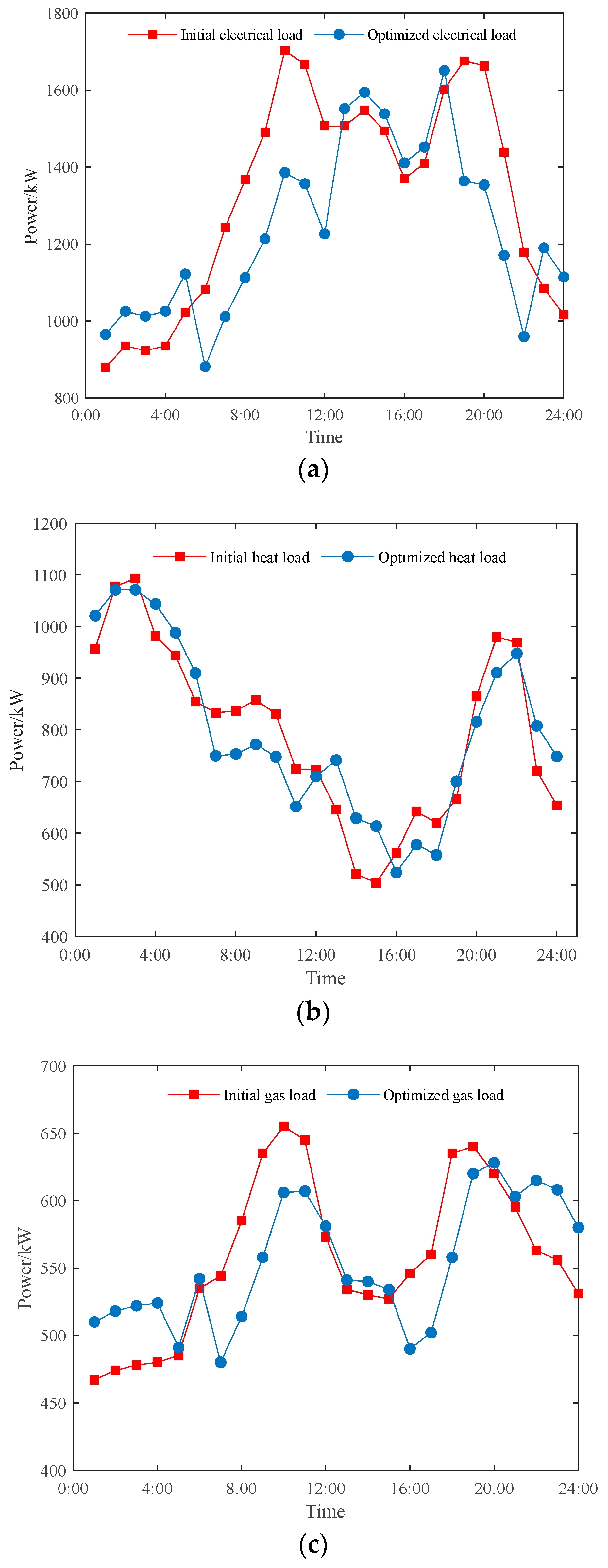

References
- Chen, Y.; Wang, Y.; Kirschen, D.; Zhang, B. Model-free renewable scenario generation using generative adversarial networks. IEEE Trans. Power Syst. 2018, 33, 3265–3275. [Google Scholar] [CrossRef] [Green Version]
- Song, Y.; Wang, D.; He, W.; Xiong, H.; Wang, P.; Lei, Y. Research on multi-objective stochastic planning of a micro energy grid with multiple clean energy sources based on scenario construction technology. Power Syst. Prot. Control. 2021, 49, 20–31. [Google Scholar]
- Falsafi, H.; Zakariazadeh, A.; Jadid, S. The role of demand response in single and multi-objective wind-thermal generation scheduling: A stochastic programming. Energy 2014, 64, 853–867. [Google Scholar] [CrossRef]
- Zhou, J.; Wu, Y.; Wu, C.; Deng, Z.; Xu, C.; Hu, Y. A hybrid fuzzy multi- criteria decision-making approach for performance analysis and evaluation of park-level integrated energy system. Energy Convers. Manag. 2019, 201, 112134. [Google Scholar] [CrossRef]
- Li, H.; Kong, Z.; Tao, C. Reliability Evaluation of electric-gas integrated energy system considering the multi-state model of natural gas pipeline network. Proc. CSEE 2022, 42, 6247–6260. [Google Scholar]
- Pan, C.; Jin, T.; Li, N.; Wang, G.; Hou, X.; Gu, Y. Multi-objective and two-stage optimization study of integrated energy systems considering P2G and integrated demand responses. Energy 2023, 270, 126846. [Google Scholar] [CrossRef]
- Chen, J.; Hu, Z.; Chen, Y.; Chen, J.; Chen, W.; Gao, M.; Lin, M.; Du, Y. Thermoelectric optimization of integrated energy system considering ladder-type carbon trading mechanism and electric hydrogen production. Electr. Power Autom. Equip. 2021, 41, 48–55. [Google Scholar]
- Gao, Y.; Wang, Q.; Chen, Y.; Ye, W.; Liu, G.; Yin, X. Optimal dispatch of integrated energy system with hydrogen considering demand response and cascade energy utilization. Autom. Electr. Power Syst. 2023, 47, 51–59. [Google Scholar]
- Liu, X.; Nie, F.; Yang, D.; Wang, Y.; Xu, Y. Low carbon economic dispatch of integrated energy systems considering green certificates-carbon trading mechanism under CCPP-P2G joint operation model. Power Syst. Technol. 2023, 47, 2207–2222. [Google Scholar]
- Yang, X.; Zhang, Z.; Mei, L.; Wang, X.; Deng, Y.; Wei, S.; Liu, X. Optimal configuration of improved integrated energy system based on stepped carbon penalty response and improved power to gas. Energy 2023, 263, 125985. [Google Scholar] [CrossRef]
- Wang, H.; Hua, P.; Wu, X.; Zhang, R.; Granlund, K.; Li, J.; Zhu, Y.; Lahdelma, R.; Teppo, E.; Yu, L. Heat-power decoupling and energy saving of the CHP unit with heat pump based waste heat recovery system. Energy 2022, 250, 123846. [Google Scholar] [CrossRef]
- Shi, J.; Xu, J.; Zeng, B.; Zhang, J. A bi-level optimal operation for energy hub based on regulating heat-to-electric ratio mode. Power Syst. Technol. 2016, 40, 2959–2966. [Google Scholar]
- Chen, Y.; Ma, Y.; Zheng, G.; Sun, Z.; Chen, D.; Gao, Y. Units Considering demand response coordinated planning of thermo-electrolytic coupling for multiple CHP. Power Grid Technol. 2022, 46, 3821–3832. [Google Scholar]
- Kang, L.; Wang, J.; Yuan, X.; Cao, Z.; Yang, Y.; Deng, S.; Zhao, J.; Wang, Y. Research on energy management of integrated energy system coupled with organic Rankine cycle and power to gas. Energy Convers. Manag. 2023, 287, 117117. [Google Scholar] [CrossRef]
- Kalan, A.S.; Heidarabadi, S.; Khaleghi, M.; Ghiasirad, H.; Skorek-Osikowska, A. Biomass-to-energy integrated trigeneration system using supercritical CO2 and modified Kalina cycles: Energy and exergy analysis. Energy 2023, 270, 126845. [Google Scholar] [CrossRef]
- Ye, C.; Cao, K.; Ding, K.; Chen, Q.; Qian, Y. Uncertain optimal dispatch strategy based on generalized energy storage for multi-energy system. Trans. China Electrotech. Soc. 2021, 36, 3753–3764. [Google Scholar]
- Chen, C.; Wu, X.; Li, Y.; Zhu, X.; Li, Z.; Ma, J.; Qiu, W.; Liu, C.; Lin, Z.; Yang, L.; et al. Distributionally robust day-ahead scheduling of park-level integrated energy system considering generalized energy storages. Appl. Energy 2021, 302, 117493. [Google Scholar] [CrossRef]
- Malozyomov, B.V.; Martyushev, N.V.; Kukartsev, V.A.; Kukartsev, V.V.; Tynchenko, S.V.; Klyuev, R.V.; Zagorodnii, N.A.; Tynchenko, Y.A. Study of Supercapacitors Built in the Start-Up System of the Main Diesel Locomotive. Energies 2023, 16, 3909. [Google Scholar] [CrossRef]
- Shchurov, N.I.; Dedov, S.I.; Malozyomov, B.V.; Shtang, A.A.; Martyushev, N.V.; Klyuev, R.V.; Andriashin, S.N. Degradation of Lithium-Ion Batteries in an Electric Transport Complex. Energies 2021, 14, 8072. [Google Scholar] [CrossRef]
- Wang, R.; Wu, J.; Cai, Z.; Liu, G.; Zhang, H.; Cai, J. Three-stage collaborative optimal scheduling of electricity-gas-heat in virtual power plant with generalized energy storage. Power Syst. Technol. 2022, 46, 1857–1868. [Google Scholar]
- Zhu, X.; Yang, J.; Liu, Y.; Liu, C.; Miao, B.; Chen, L. Optimal scheduling method for a regional integrated energy system considering joint virtual energy storage. IEEE Access 2019, 7, 138260–138272. [Google Scholar] [CrossRef]
- Liu, Z.; Yu, P.; Li, J. Planning of distributed generation and generalized energy storage in distribution network considering operation characteristic. Electr. Power Autom. Equip. 2023, 43, 72–79. [Google Scholar]
- Li, H.; Fang, Y.; Xiao, B. Research on Optimized Operation of Regional Integrated Energy System Considering Generalized Energy Storage. Power Syst. Technol. 2019, 43, 3130–3138. [Google Scholar]
- Yang, Y.; Li, Q.; Pu, Y.; Chen, X.; Chen, W. Optimal configuration of CHHP island IES considering different charging modes of electric vehicles. Power Syst. Technol. 2022, 46, 3869–3880. [Google Scholar]
- Li, D.; Zhang, K.; Yao, Y.; Lin, S. Day-ahead demand response scheduling strategy of an electric vehicle aggregators based on information gap decision theory. Power Syst. Prot. Control. 2022, 50, 101–111. [Google Scholar]
- Tan, Z.; Ju, L.; Li, H.; Li, J.; Zhang, H. A two-stage scheduling optimization model and solution algorithm for wind power and energy storage system considering uncertainty and demand response. Int. J. Electr. Power Energy Syst. 2014, 63, 1057–1069. [Google Scholar] [CrossRef]
- Qin, T.; Liu, H.; Wang, J.; Feng, Z.; Fang, W. Carbon trading based low-carbon economic dispatch for integrated electricity-heat-gas energy system. Autom. Electr. Power Syst. 2018, 42, 8–13, 22. [Google Scholar]
- Lv, X.; Liu, T.; Liu, Y.; He, C.; Nan, L.; Zeng, H. Low-carbon economic dispatch of multi-energy park considering high proportion of renewable energy. J. Shanghai Jiaotong Univ. 2021, 55, 1586. [Google Scholar]

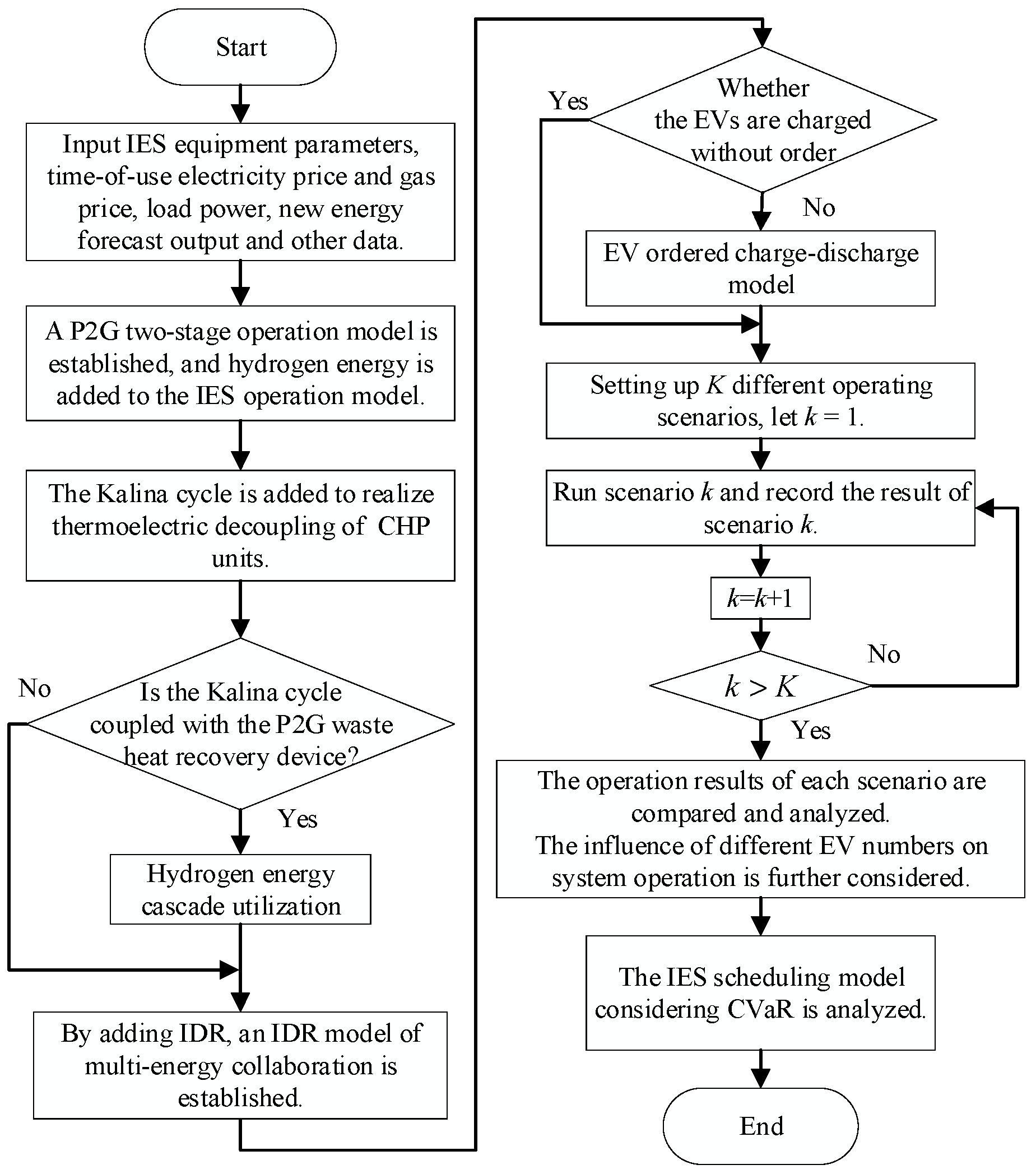
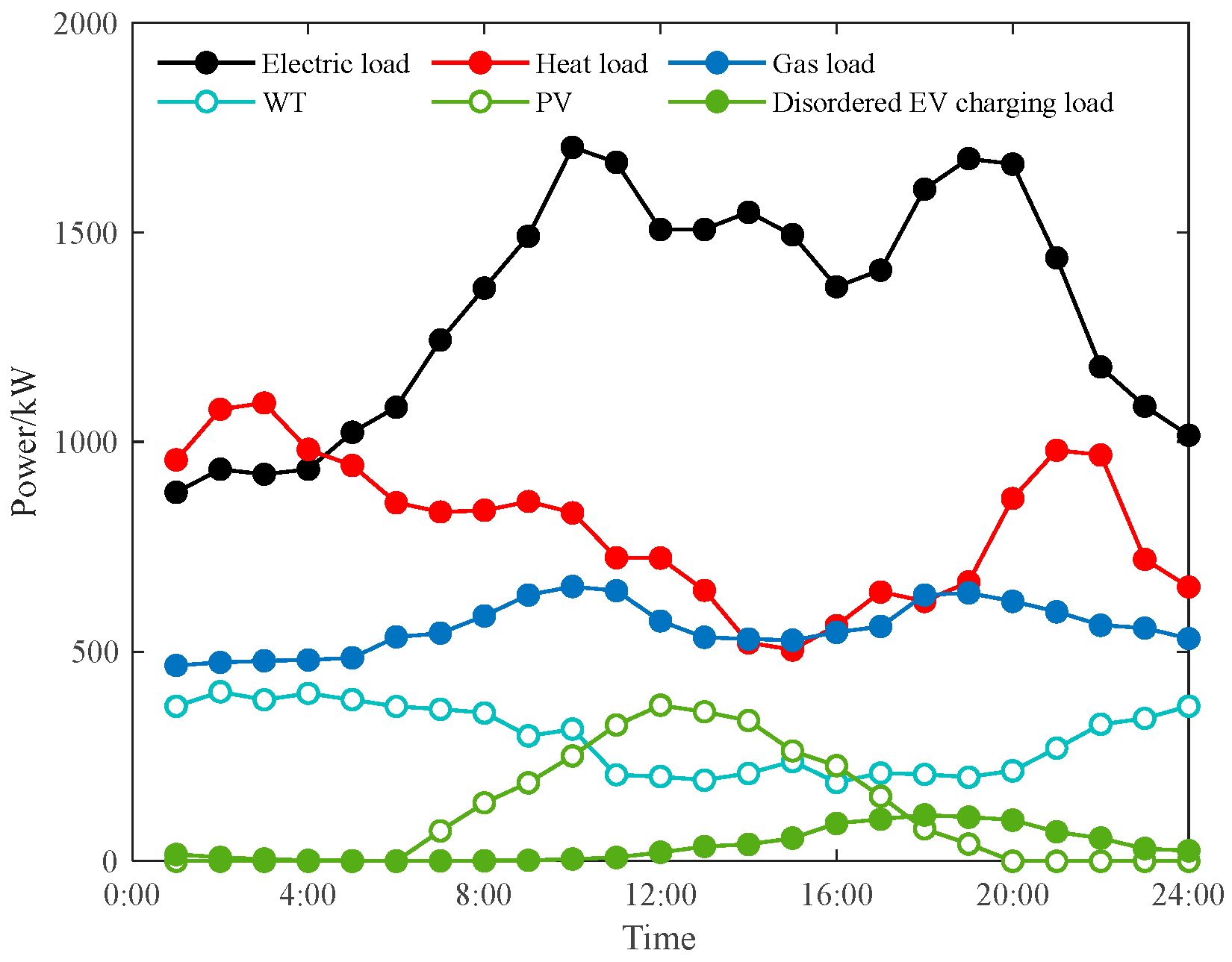

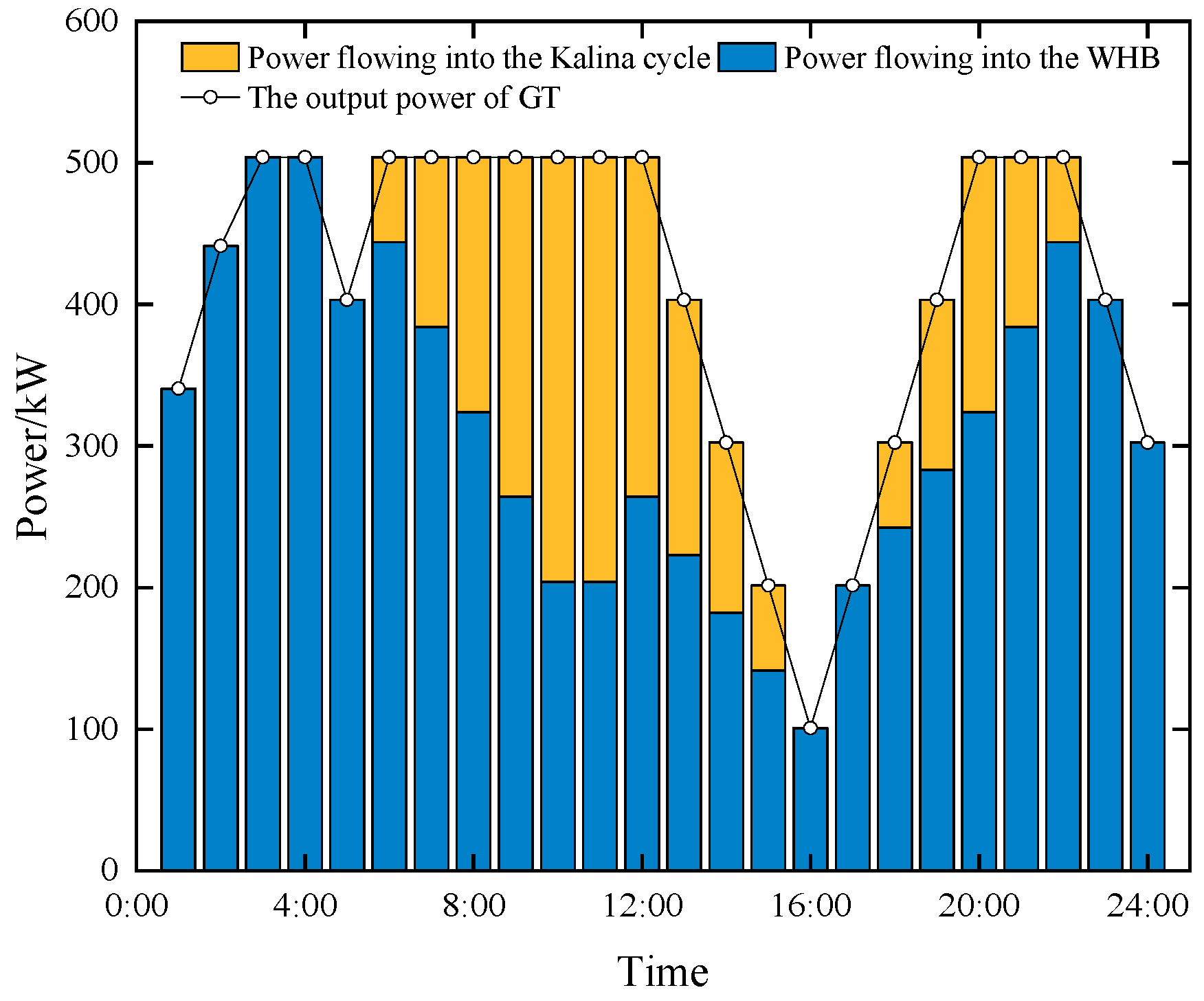
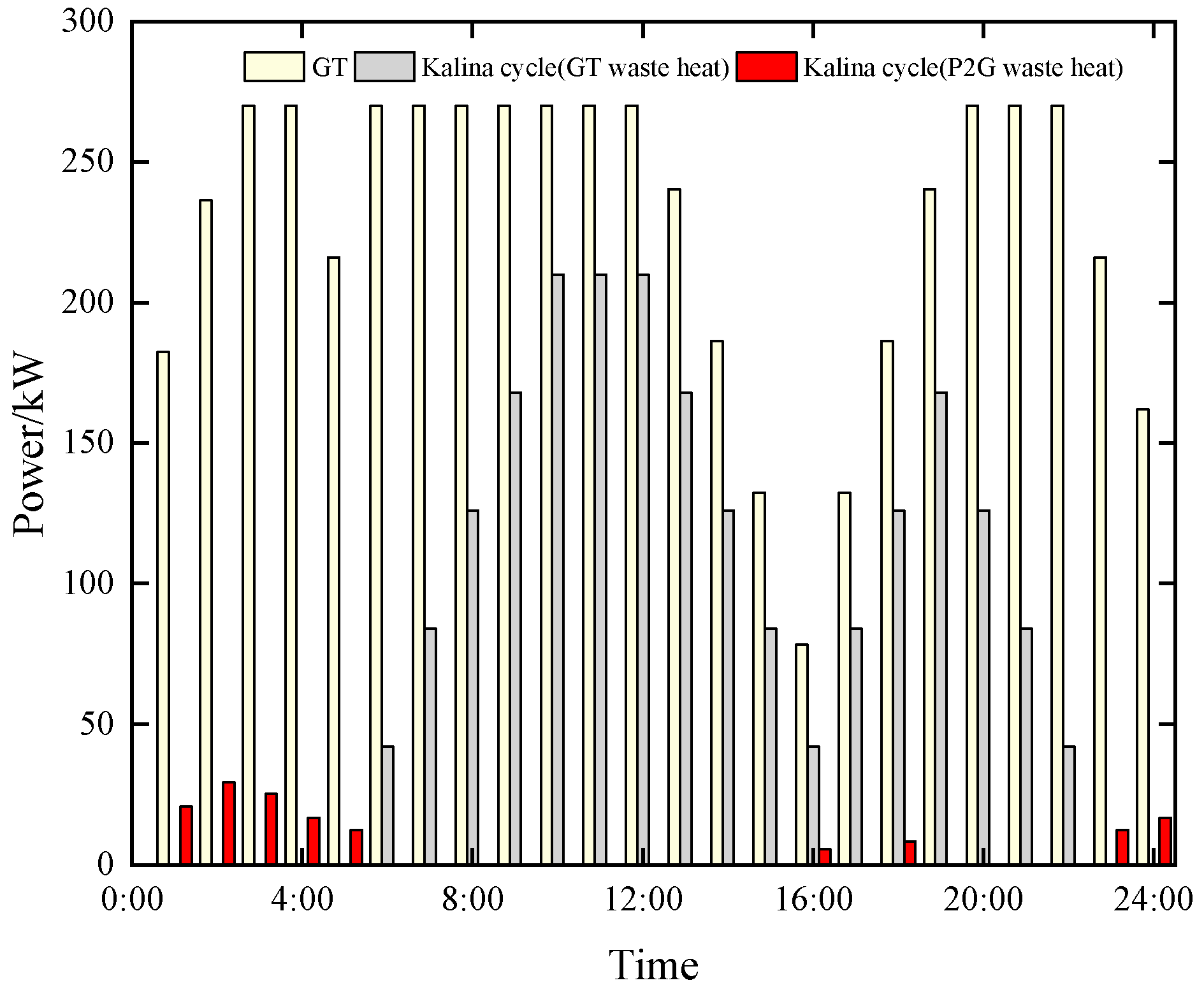
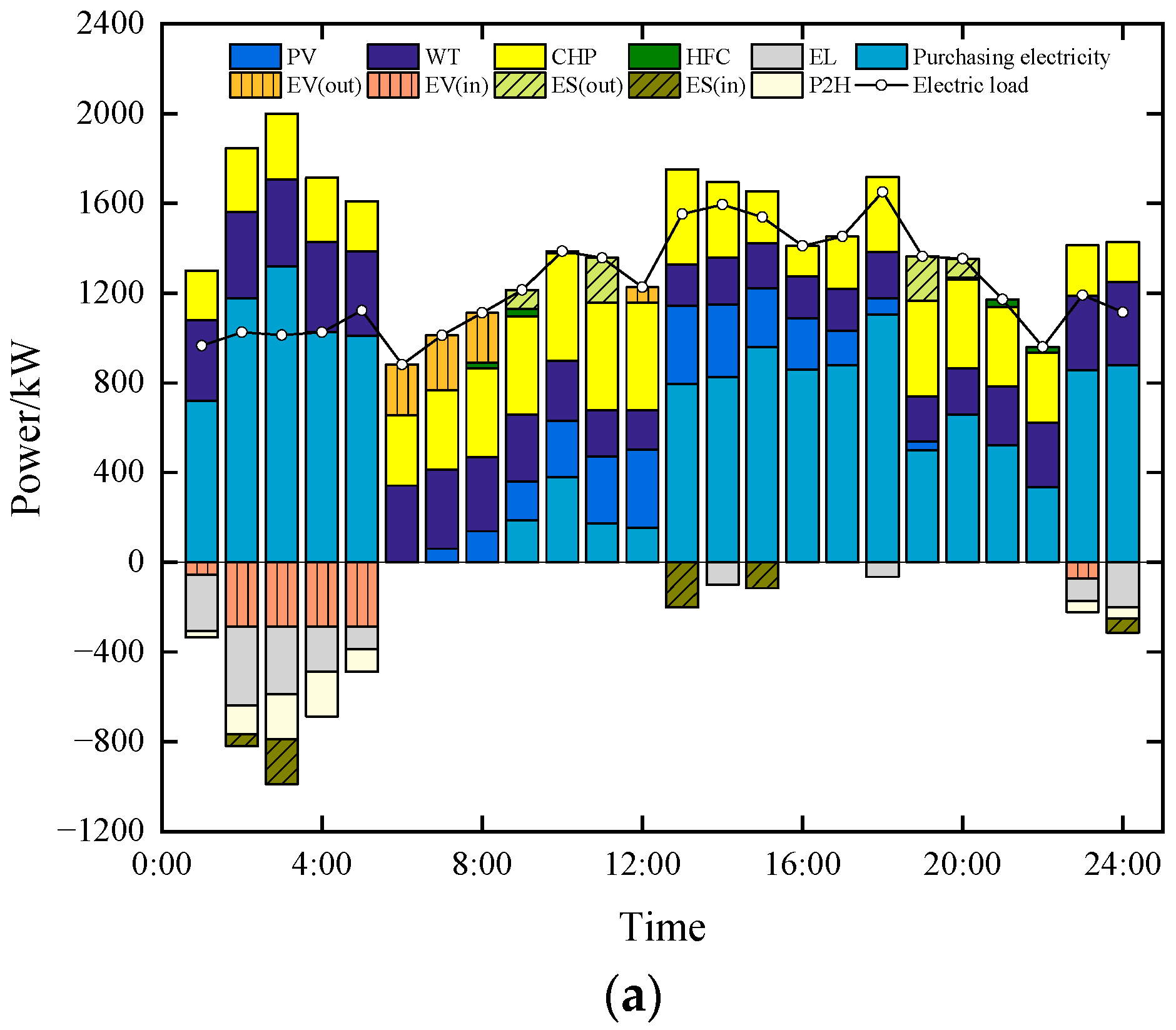

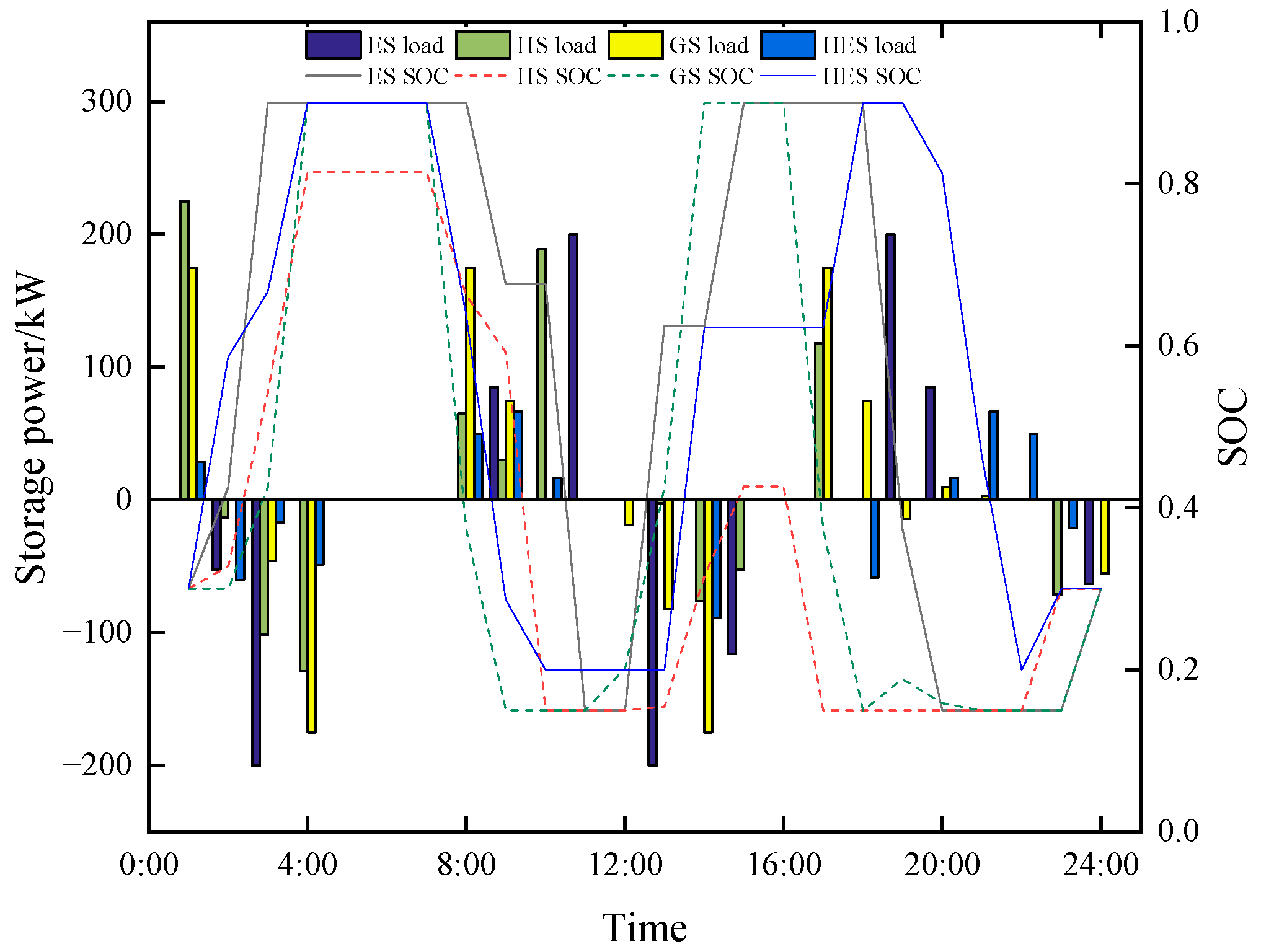
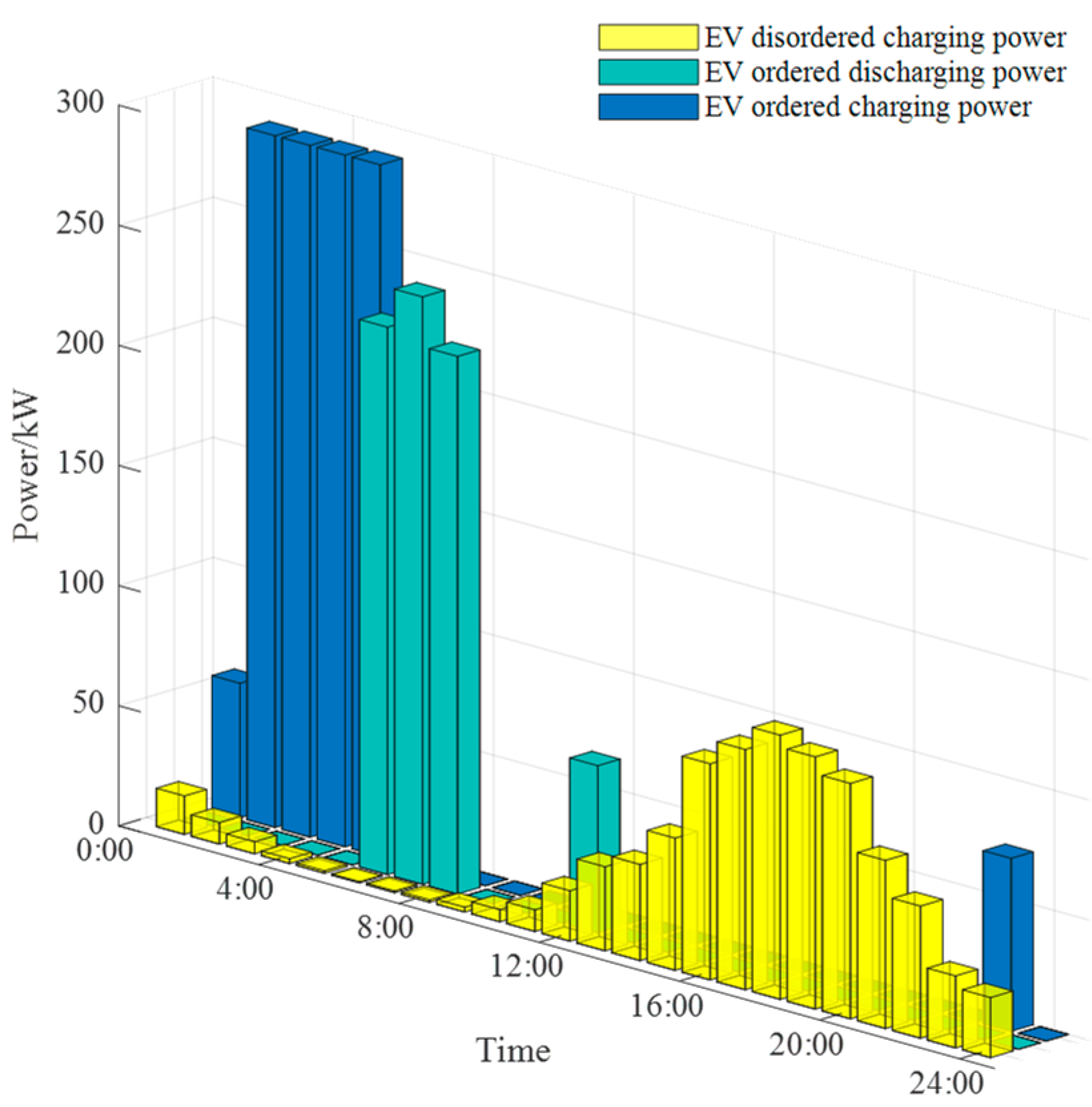
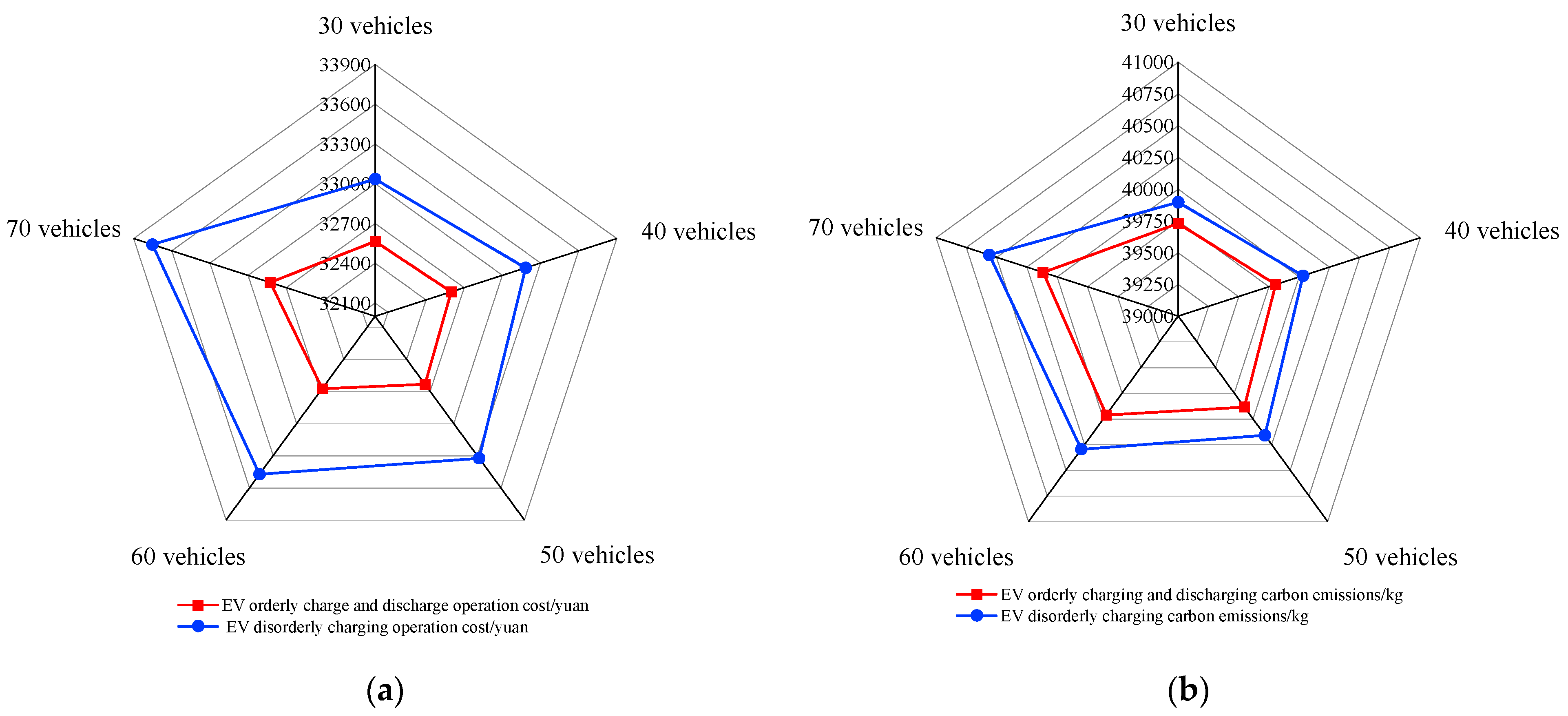
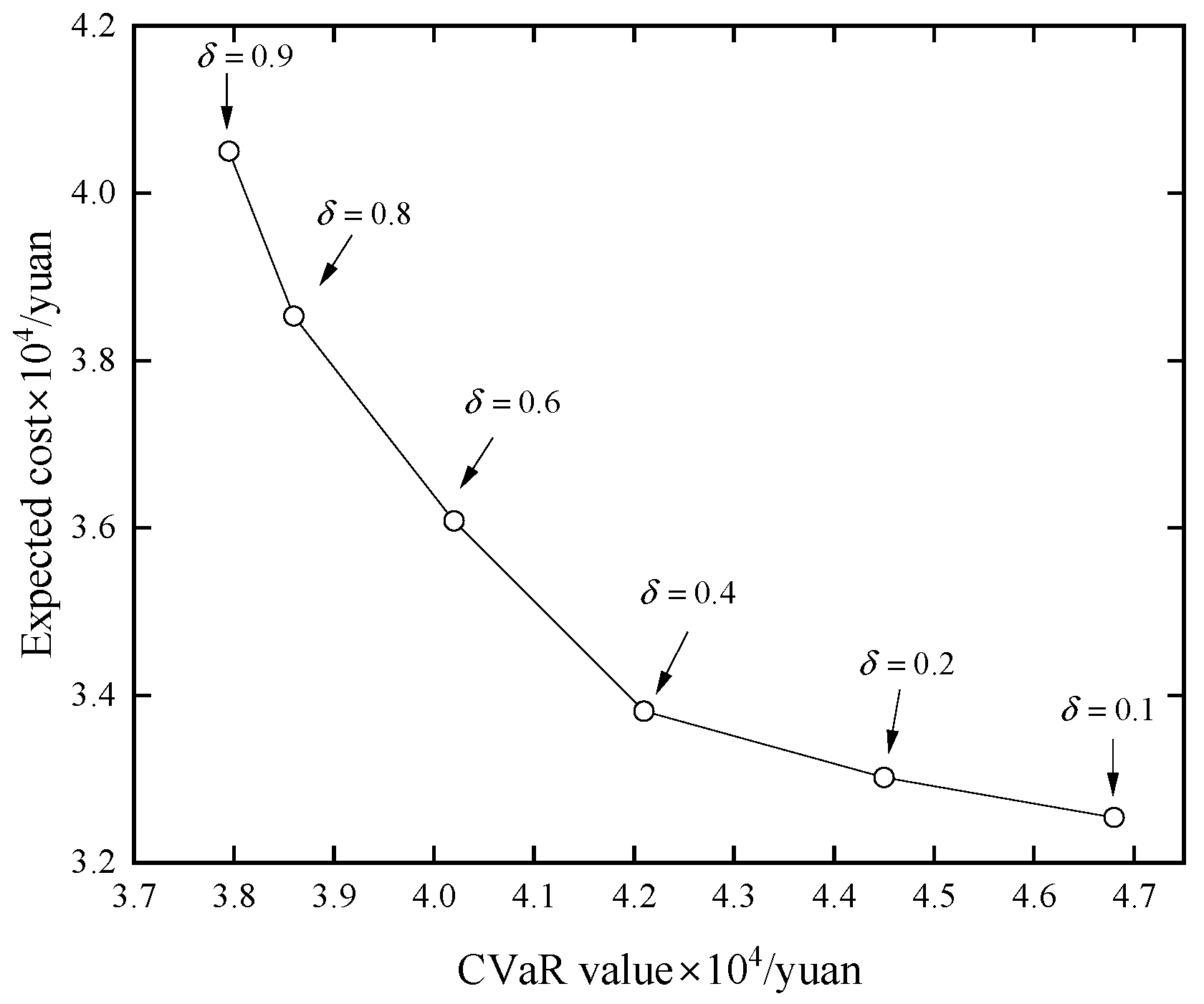
| Scenarios | Operation and Maintenance Cost/Yuan | Electricity Purchase Cost/Yuan | Gas Purchase Cost/Yuan | Carbon Emissions/Kg | Carbon Transaction Cost/Yuan | New Energy Consumption Rate/% | Total Cost/Yuan |
|---|---|---|---|---|---|---|---|
| 1 | 887.19 | 16,454.94 | 12,118.62 | 41,270.21 | 7618.01 | 87.36 | 37,078.76 |
| 2 | 883.57 | 15,106.50 | 12,896.11 | 40,761.94 | 7380.28 | 92.54 | 36,266.46 |
| 3 | 886.19 | 14,945.81 | 12,903.48 | 40,581.19 | 7346.97 | 93.88 | 36,082.45 |
| Scenarios | Operation and Maintenance Cost/Yuan | Electricity Purchase Cost/Yuan | Gas Purchase Cost/Yuan | Carbon Emissions/Kg | Carbon Transaction Cost/Yuan | Demand Response Cost/Yuan | Total Cost/Yuan |
|---|---|---|---|---|---|---|---|
| 4 | 1084.98 | 14,385.65 | 16,081.13 | 49,081.17 | 7438.61 | 0 | 38,990.37 |
| 5 | 911.52 | 11,767.23 | 12,820.50 | 40,295.08 | 7004.31 | 960.17 | 33,463.73 |
| 6 | 910.61 | 10,618.63 | 12,830.13 | 39,961.06 | 6972.38 | 1343.23 | 32,674.98 |
Disclaimer/Publisher’s Note: The statements, opinions and data contained in all publications are solely those of the individual author(s) and contributor(s) and not of MDPI and/or the editor(s). MDPI and/or the editor(s) disclaim responsibility for any injury to people or property resulting from any ideas, methods, instructions or products referred to in the content. |
© 2023 by the authors. Licensee MDPI, Basel, Switzerland. This article is an open access article distributed under the terms and conditions of the Creative Commons Attribution (CC BY) license (https://creativecommons.org/licenses/by/4.0/).
Share and Cite
Liu, Z.; Li, C. Low-Carbon Economic Optimization of Integrated Energy System Considering Refined Utilization of Hydrogen Energy and Generalized Energy Storage. Energies 2023, 16, 5700. https://doi.org/10.3390/en16155700
Liu Z, Li C. Low-Carbon Economic Optimization of Integrated Energy System Considering Refined Utilization of Hydrogen Energy and Generalized Energy Storage. Energies. 2023; 16(15):5700. https://doi.org/10.3390/en16155700
Chicago/Turabian StyleLiu, Zifa, and Chengchen Li. 2023. "Low-Carbon Economic Optimization of Integrated Energy System Considering Refined Utilization of Hydrogen Energy and Generalized Energy Storage" Energies 16, no. 15: 5700. https://doi.org/10.3390/en16155700







